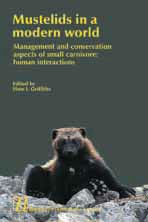

The mustelids - otters, badgers, martens, weasels and
their allies - make up one of the most diverse families of modern-day carnivores.
However, unlike many other carnivore families, mustelids have rarely attracted
the attention, interest or sympathy of the public. Human attitudes to mustelids
are fraught with contradictions. Almost every school child knows of the highly
photogenic otters and, in parts of western Europe, badger conservation and welfare
evokes emotions that often seem to verge on the fanatical. In contrast, many
other people view mustelids rather more negatively. Gamekeepers and hunters
may see them as killers of ground-nesting gamebirds and their chicks, farmers
often perceive them as pests (menaces to crops or livestock), and public health
officials worry about plague, rabies and bovine tuberculosis. To add to the
confusion, many mustelids are economically significant as furbearers, so adding
all the controversy associated with the fur industry.
Despite these diverse views, mustelids are the most common predatory mammals
in many northern-hemisphere ecosystems. Furthermore, like all other predatory
species, they exist under increasing pressure in a world where human population
and infrastructure permeate even the wildernesses. So, even in a society with
a growing conservation ethic, mustelids are often hunted or persecuted, and
their habitats are being altered, fragmented and eroded (as are those of their
prey species). Survival in the modern, human-dominated world seems a challenging
prospect.
The present volume arose out of informal discussions held around the mustelid
session of the Euro-American Mammal Congress in Santiago de Compostela (Spain)
in July 1998. This gave workers from many countries and a broad range of disciplines
the chance to come together, and to compare experiences and viewpoints. This
was a relatively rare occasion as mustelid specialists tend align with one or
other of the two relevant IUCN groups (Small Carnivores, Otters). As few technical
or popular works deal with mustelids, it was felt that it was timely to take
a wider view, and to examine themes relevant to the conservation of the group
as a whole. The result is the present volume; a selection of invited thematic
essays and research papers that aims to provide "snap shots" which explore some
aspects of how these creatures live in human-dominated landscapes. We cannot,
of course deal with every problem faced by every species, but I hope that the
result does illustrate the major issues, and provides some insights as to how
these magnificent animals can survive in the new millennium.
Preface
Authors addresses
1. Conservation of Scandinavian wolverines in
ecological and political landscapes
Arild Landa John D.C. Linnell, Mats Lindén, Jon E. Swenson, Eivin Røskaft
& Arne Moksnes
2. A comparison of the management of stoats and
weasels in Great Britain and New Zealand
Robbie A. McDonald & Elaine C. Murphy
3. The conservation status of New World mustelids
Steven W. Buskirk
4. The impact of human activities on North American
mustelids
Gilbert Proulx
5. Management and conservation of mustelids in
Ontario and eastern Canada
Jean-François Robitaille
6. Black-footed ferrets: recovering an endangered
species in an endangered habitat
Astrid Vargas, Pete Gober, Mike Lockhart & Paul Marinari
7. American river otters, Lontra canadensis,
and humans: occurrence in a coastal urban habitat and reaction to increased
levels of disturbance
Peter Giere & Don S. Eastman
8. Prehistoric mustelid exploitation: an overview
Ruth Charles
9. The recovery of the polecat, Mustela putorius,
in Britain
Johnny D.S. Birks
10. Conservation implications of hybridisation
between polecats, ferrets and European mink (Mustela spp.)
Angus Davison, Johnny D.S. Birks, Tiit Maran, David W. Macdonald, Vadim E. Sidorovich
& Huw I. Griffiths
11. Otters recovering in man-made habitats in
central Europe
Andreas Kranz & Ales Toman
12. The application of Geographic Information
Systems and computer modelling to mustelid research
Mary C. Gough & Steve P. Rushton
13. A spatial analysis of mustelid distributions
in northern Italy
Lorenzo Fornasari, Luciano Bani, Ivan Bonfanti, Elisabetta de Carli & Renato
Massa
14. Monitoring the very rare: pine marten populations
in England and Wales
John E. Messenger & Johnny D.S. Birks
15. Factors influencing otter, Lutra lutra, numbers
and distribution on part of the Blackwater catchment (Ireland)
Paola Ottino & Paul Giller
16. Wildlife management and scientific research:
a retrospective evaluation of two badger removal operations for the control
of bovine tuberculosis
Frank A.M. Tuyttens, Lucy Barron, Lucy M. Rogers, Peter J. Mallinson & David
W. Macdonald
17. Changes in badger, Meles meles, social organisation
in response to increasing population density at Woodchester Park, south-west
England
Lucy M. Rogers, Richard J. Delahay, Tim D. Hounsome & Chris L. Cheeseman
18. Mustelids in the Balkans - small carnivores
in the European biodiversity hot-spot
Boris Kryztufek
19. The on-going decline of riparian mustelids
(European mink, Mustela lutreola, polecat, Mustela putorius, and stoat, Mustelaerminea)
in eastern Europe: a review of the results to date and an hypothesis.
Vadim E. Sidorovich
20. The marbled polecat, Vormela peregusna (Güldenstaedt,
1770), in FR Yugoslavia an elsewhere
Miroljub Milenkoviç, Milan Paunoviç, Helen E. Abel & Huw I.
Griffiths
21. The status and conservation of Taiwan's mustelids
Liang-Kong Lin
Index to scientific names, Subject index
Edited by Huw I. Griffiths
2000, x and 342 pages with 76 figures and 35 tables.
Paperbound.
ISBN 90-5782-066-8
€ 84